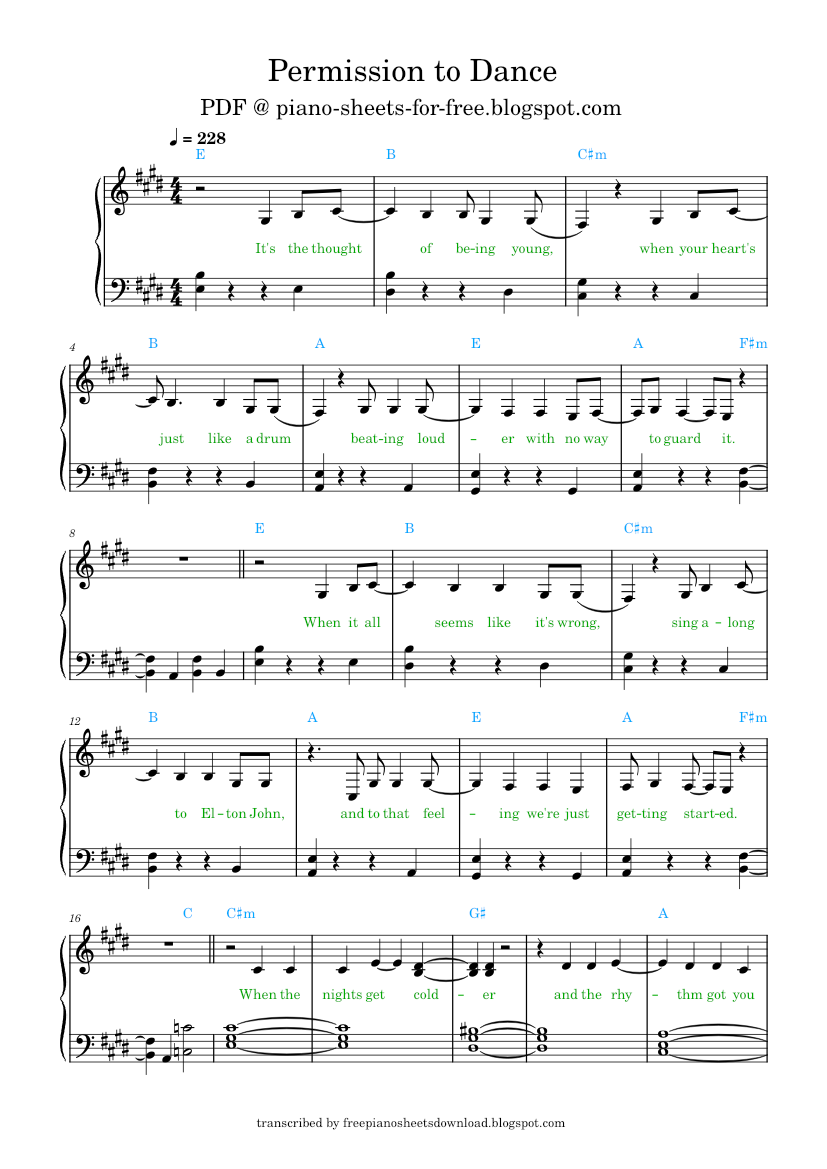Written by Ed Sheeran.
Simplicity: Easy (If you are a beginner, read below practice and performance notes on how to play this sheet music)
💾 Download PDF from GoogleDrive (283 kB, 6 pages)

🔎 More BTS Songs
💽 Permission to Dance Composition
The K-Pop-piece ‘Permission to Dance’ by BTS premiered on
Read a Wikipedia entry.
Listen on Spotify while sight-reading the score.
Pianistically, the score has no technical difficulties:
- In the PDF the vocal line is written one octave higher than recorded. If you want to sing along, sing one octave lower.
- Tempo is 124 beats per minute. I doubled note values to make sightreading easier for the youngest BTS fans.
- A key is E Major, the key that seems “bright and powerful”. A piano should be able to sound like anything, so play sunny and childlike.
- Music is colored by moving between minor and major chords: the progression combines E C#m A F#m. It makes the sound of ‘Permission to Dance’ close to a sound of several songs. You can mix choruses with verses from different songs to develop skills
🎹 Learn Permission to Dance Sheet Music on Piano
📅 Practicing
- Stretch and warm-up every time you play.
- Touch the keys with fingertips not with whole finger pulps (cut nails short).
- Practice no more than three repetitions in a row (otherwise you lose focus.)
🏁 Motivation
- Set a goal — an accessible goal (eg. to post a video of your performance on YouTube in one week, play on your relative’s birthday in a month, etc.) It will keep you motivated and concentrated. Perform and post even if you aren’t satisfied with the result. Shame is a driver, too!
- Record yourself on a dictaphone, listen to the record on the next day, and write down on the printed score what mistakes you want to improve (the left hand is too loud, the beats aren’t accentuated).
- Micropractice on days when you don’t want to play piano but press yourselves into it. Play only the most complicated moments and then stop. It will take only a few minutes and be far more productive than playing a session without focus.
𝄞 Melody
- The right hand plays a melody. The melody should shine out above the accompaniment of the left hand and leave a lasting impression.
- Add fingering in dense places (on printed pages or use a “comment” feature in your pdf-viewer.) Aim for less change of hand position. 5-4-3-2-1 is better than 4-3-2-1-2. Play all notes within a phrase together simultaneously — you will understand the comfortable fingering.
- Count out loud. The truth is that listeners are far less concerned about wrong notes than an inconsistent pulse, a lack of rhythmic control or a sense of rhythmic instability.
Put the metronome at 50 beats per minute. Then 52. Then 54, etc. until you reach the original tempo. - Focus on differences in touch and attack: articulation (legato vs. staccato) and dynamics (loud vs. quiet). Vary them throughout the piece. Manually put down piano/forte (𝓟 🙵 𝓕), crescendo/diminuendo (< 🙵 >), legato/staccato markings with a highlighter.
- Mark phrases with a highlighter in a bubble. Play the first half of any phrase louder than the last half. Accentuate the highest-pitched note of a phrase.
- Wherever you see a slur (♩⁀♪), play the second slurred note very quietly.
𝄢 Accompaniment
- The left hand plays an accompaniment and is always softer than the right hand and has no phrasing, so give every first beat of every measure an accent.
- Keep the upper notes (played by the thumb) lighter and the lower notes (played by the pinky) louder. The thumb uses the least weight.
- Put fingers close to the black keys.
- If you feel fatigue in the left hand, modify the score:
- leave out notes,
- transfer the top notes to your right hand,
- arpeggiate or break the chord in an upward pattern.
- Rotate the wrist, elbow, and forearm.
🅿 Pedal
Pedal as little as possible to push the melody forward. Like fingering, pedaling marks should be added personally to suit your
- palm (small palms need help of the pedal to connect large intervals),
- piano (smaller or digital pianos are forgiving to over-pedaling),
- room size (an open space needs more pedaling).
Pedal twice per measure or more. Delay pedal pressing for milliseconds to weaken the resonance. Remove the pedal wherever you see a rest symbol.
🧠 How to Memorize Sheet Music
Worry less that you can’t learn scores — the best pianists in the world learn their concert pieces for no less than two years prior to the first performance. Learning more pieces makes it easier to memorize a single one. I post a score every other day, so sight-read a new song everyday to develop memory.

Learn chord symbols — usually in the left hand are only several chords in a progression, so it is easier to remember. To learn the progression
- sing root notes (the first letter of a chord symbol) as a melody,
- create a word made of the first letters of the chord progression.
Understand the structure of ‘Permission to Dance’: parts are separated by a double bar line (‖). Work on the hardest parts more than on the easiest.
From the very first time, try to recall or play by ear a part after you played it, part by part.